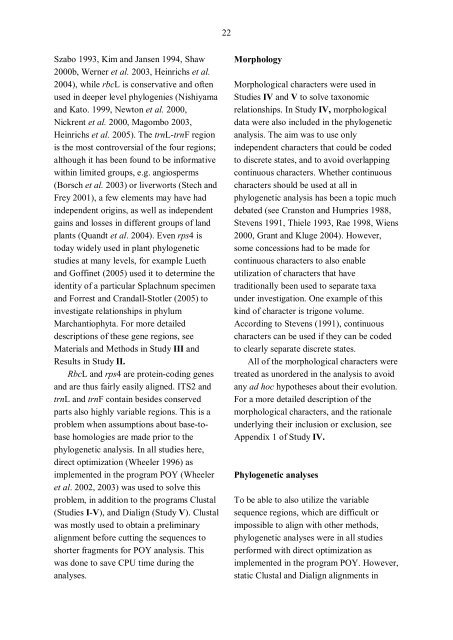Evolutionary relationships of liverworts with a special focus ... - Doria
Evolutionary relationships of liverworts with a special focus ... - Doria
Evolutionary relationships of liverworts with a special focus ... - Doria
You also want an ePaper? Increase the reach of your titles
YUMPU automatically turns print PDFs into web optimized ePapers that Google loves.
22<br />
Szabo 1993, Kim and Jansen 1994, Shaw<br />
2000b, Werner et al. 2003, Heinrichs et al.<br />
2004), while rbcL is conservative and <strong>of</strong>ten<br />
used in deeper level phylogenies (Nishiyama<br />
and Kato. 1999, Newton et al. 2000,<br />
Nickrent et al. 2000, Magombo 2003,<br />
Heinrichs et al. 2005). The trnL-trnF region<br />
is the most controversial <strong>of</strong> the four regions;<br />
although it has been found to be informative<br />
<strong>with</strong>in limited groups, e.g. angiosperms<br />
(Borsch et al. 2003) or <strong>liverworts</strong> (Stech and<br />
Frey 2001), a few elements may have had<br />
independent origins, as well as independent<br />
gains and losses in different groups <strong>of</strong> land<br />
plants (Quandt et al. 2004). Even rps4 is<br />
today widely used in plant phylogenetic<br />
studies at many levels, for example Lueth<br />
and G<strong>of</strong>finet (2005) used it to determine the<br />
identity <strong>of</strong> a particular Splachnum specimen<br />
and Forrest and Crandall-Stotler (2005) to<br />
investigate <strong>relationships</strong> in phylum<br />
Marchantiophyta. For more detailed<br />
descriptions <strong>of</strong> these gene regions, see<br />
Materials and Methods in Study III and<br />
Results in Study II.<br />
RbcL and rps4 are protein-coding genes<br />
and are thus fairly easily aligned. ITS2 and<br />
trnL and trnF contain besides conserved<br />
parts also highly variable regions. This is a<br />
problem when assumptions about base-tobase<br />
homologies are made prior to the<br />
phylogenetic analysis. In all studies here,<br />
direct optimization (Wheeler 1996) as<br />
implemented in the program POY (Wheeler<br />
et al. 2002, 2003) was used to solve this<br />
problem, in addition to the programs Clustal<br />
(Studies I-V), and Dialign (Study V). Clustal<br />
was mostly used to obtain a preliminary<br />
alignment before cutting the sequences to<br />
shorter fragments for POY analysis. This<br />
was done to save CPU time during the<br />
analyses.<br />
Morphology<br />
Morphological characters were used in<br />
Studies IV and V to solve taxonomic<br />
<strong>relationships</strong>. In Study IV, morphological<br />
data were also included in the phylogenetic<br />
analysis. The aim was to use only<br />
independent characters that could be coded<br />
to discrete states, and to avoid overlapping<br />
continuous characters. Whether continuous<br />
characters should be used at all in<br />
phylogenetic analysis has been a topic much<br />
debated (see Cranston and Humpries 1988,<br />
Stevens 1991, Thiele 1993, Rae 1998, Wiens<br />
2000, Grant and Kluge 2004). However,<br />
some concessions had to be made for<br />
continuous characters to also enable<br />
utilization <strong>of</strong> characters that have<br />
traditionally been used to separate taxa<br />
under investigation. One example <strong>of</strong> this<br />
kind <strong>of</strong> character is trigone volume.<br />
According to Stevens (1991), continuous<br />
characters can be used if they can be coded<br />
to clearly separate discrete states.<br />
All <strong>of</strong> the morphological characters were<br />
treated as unordered in the analysis to avoid<br />
any ad hoc hypotheses about their evolution.<br />
For a more detailed description <strong>of</strong> the<br />
morphological characters, and the rationale<br />
underlying their inclusion or exclusion, see<br />
Appendix 1 <strong>of</strong> Study IV.<br />
Phylogenetic analyses<br />
To be able to also utilize the variable<br />
sequence regions, which are difficult or<br />
impossible to align <strong>with</strong> other methods,<br />
phylogenetic analyses were in all studies<br />
performed <strong>with</strong> direct optimization as<br />
implemented in the program POY. However,<br />
static Clustal and Dialign alignments in
















